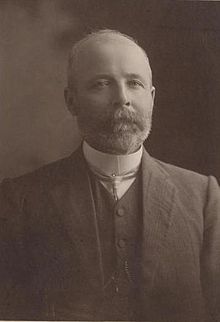Thomas Brown (New South Wales politician)
Thomas Brown | |
|---|---|
 | |
| Member of the Australian Parliament for Canobolas | |
| In office 29 March 1901 – 12 December 1906 | |
| Preceded by | New seat |
| Succeeded by | Seat abolished |
| Member of the Australian Parliament for Calare | |
| In office 12 December 1906 – 31 May 1913 | |
| Preceded by | New seat |
| Succeeded by | Henry Pigott |
| Personal details | |
| Born | 6 October 1861 Forbes, New South Wales |
| Died | 23 March 1934 (aged 72) Randwick, Sydney |
| Nationality | Australian |
| Political party | Australian Labor Party |
| Spouse | Louisa Jane Brown |
| Children | Three |
| Alma mater | University of Sydney |
| Occupation | Preacher |
Thomas Brown (6 October 1861 – 23 March 1934) was an Australian farmer and politician, born near Forbes, New South Wales, to Mitchell Brown, a domestic servant, and his wife Isabella, née Abernethy.
Brown studied at
Representing Forbes at the first Farmers and Settlers' Association conference in 1893, Brown was a skilled advocate, and was elected to the
Brown resigned from New South Wales Parliament in 1901 and, in a surprising turn of events, defeated
Defeated in Calare in 1913, Brown returned to New South Wales politics as the member for Lachlan, where he remained well known as a supporter of rural interests. Defeated by Ernest Buttenshaw in 1917, he worked for a temperance organisation before becoming secretary to the Prime Minister, Billy Hughes.[1]
Brown remained active in the Presbyterian community. In 1909 he was behind the public discussion on social issues which led to the famous clash between Prime Minister
References
- ^ OCLC 70677943. Retrieved 16 February 2010.
- ^ "Mr Thomas Brown (2) (1861–1935)". Former members of the Parliament of New South Wales. Retrieved 18 September 2019.
